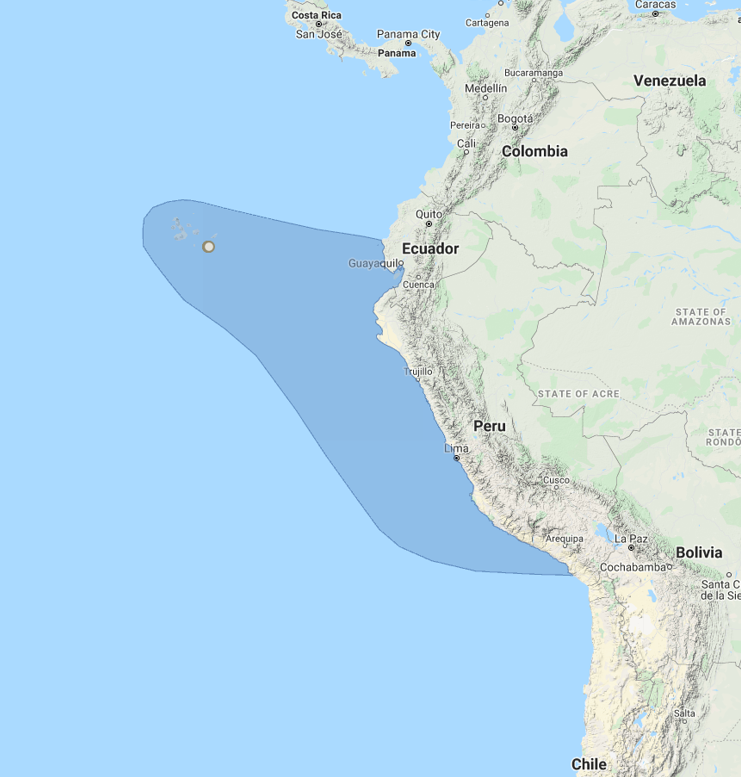Birdfinding.info ⇒ IUCN has listed the Waved Albatross as Critically Endangered since 2007, although it appears to be much more numerous than several other albatross species, and remains locally common in the Galápagos archipelago, especially around its main breeding colony on Isla Española—where it is readily observed at Punta Suarez from April to January. It is also seen regularly in transit among the Galápagos and on pelagic trips out of mainland Ecuadorian and Peruvian ports from Guayaquil to Lima.
Waved Albatross
Phoebastria irrorata
Breeds on Isla Española in the Galápagos; disperses mainly to Humboldt Current of Ecuador and Peru.
Breeding. The vast majority of pairs breed on Isla Española, the southeasternmost island in the Galápagos archipelago, where there are several loose colonies along the southern coast and a few traditional sites in the interior.
Adults return to Española around late March or early April and most juveniles fledge in January.
A few adults have been observed during the breeding season around Isla Genovesa (the northeasternmost island in the Galápagos), including some courting pairs, but nesting there has not been confirmed.
Up to 20 pairs have been found nesting on Isla de la Plata, ~20 km west of the Ecuadorian mainland.
The size of the global population is in some doubt, but it is thought to be in the midst of a long-term decline that began during the 1990s. Estimates of nesting pairs on Española from the 1970s to 1990s ranged from 12,000 to 18,000, and subsequent estimates of the entire population (breeders and nonbreeders) have ranged from 50,000 to 70,000.
Nonbreeding. Essentially resident in the waters around the Galápagos and east into its principal foraging grounds in the Humboldt Current—mostly between San Lorenzo, Ecuador, and Ica, Peru. Small numbers range farther south in the waters of southern Peru and northern Chile, and north into Colombian waters.
Occasional wanderers have been recorded on multiple occasions south to Valparaíso, offshore to Isla San Ambrosio, and less often north to Costa Rican and Panamanian waters.
Identification
Distinctive and unlikely to be confused: a mostly dark, thickset albatross with a white head and neck, a subtle buffy cowl on the crown and neck, and an outsized, disproportionately long, yellow-orange bill. No other albatross shares its basic color pattern, and its banana-like bill stands out at long range.
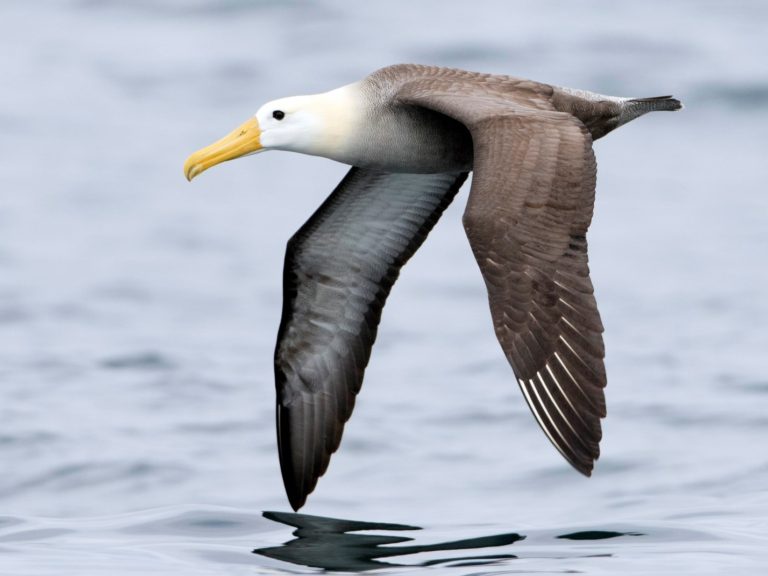
Waved Albatross. (Offshore from Isla San Lorenzo, Lima, Peru; July 12, 2017.) © Brian Sullivan
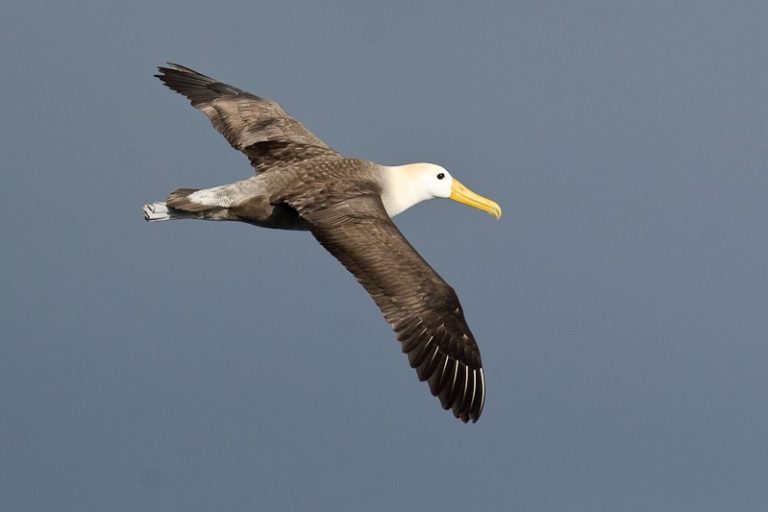
Waved Albatross, dorsal view showing contrast between short, black tail and paler gray rump. (Isla Española, Galápagos, Ecuador; June 21, 2007.) © Johnny ver der Zwaag
The upperparts appear mostly medium- to dark-gray. The rump area is noticeably paler than the back and at close range shows a finely vermiculated pattern.
The tail is short and contrastingly blackish. Its blue-gray feet usually project prominently beyond the tail in flight.
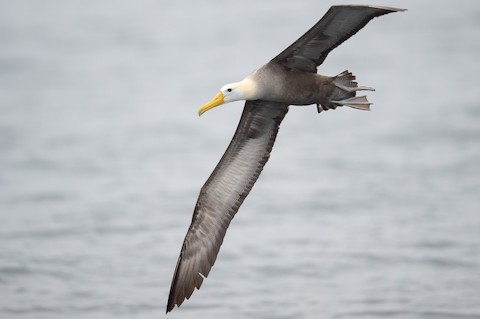
Waved Albatross, showing muted gray underwing coloration. (Offshore from Quintero, Chile; March 2, 2020.) © Billy Herman
The underparts are mostly gray, with a finely vermiculated pattern that is discernible only at very close range. The underwings also appear mostly gray, with a blackish border.
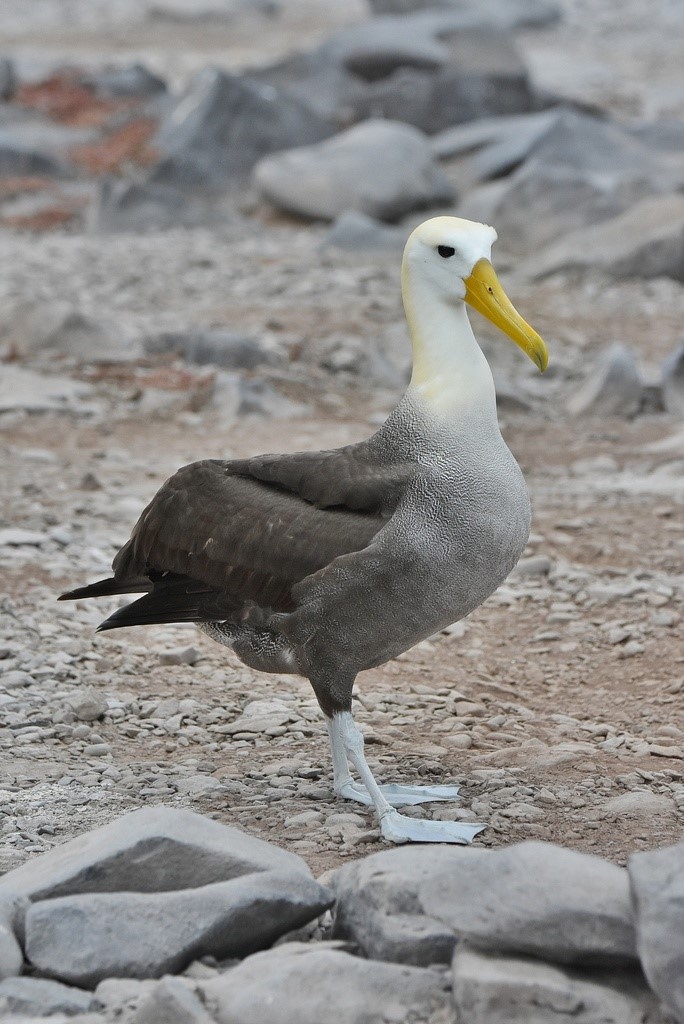
Waved Albatross, showing finely vermiculated underparts. (Isla Española, Galápagos, Ecuador; October 2019.) © Karine Scott
Immatures do not differ noticeably from adults, but the head and neck are closer to pure-white, lacking the adult’s buffy tinge.
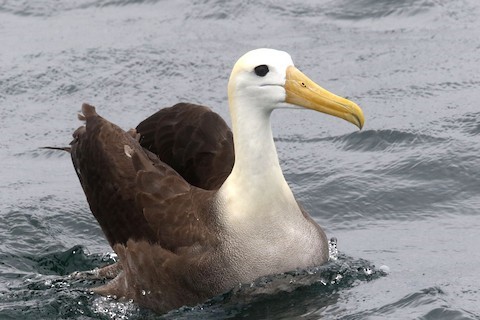
Waved Albatross, attending a chum slick. (Banco Chico, offshore from Bocapán, Tumbes, Peru; October 10, 2018.) © Noah Strycker

Waved Albatross, portrait. (Punta Suarez, Isla Española, Galápagos, Ecuador; July 30, 2018.) © David Marques
Notes
Monotypic species.
IUCN Red List Status: Critically Endangered.
Additional Photos of Waved Albatross
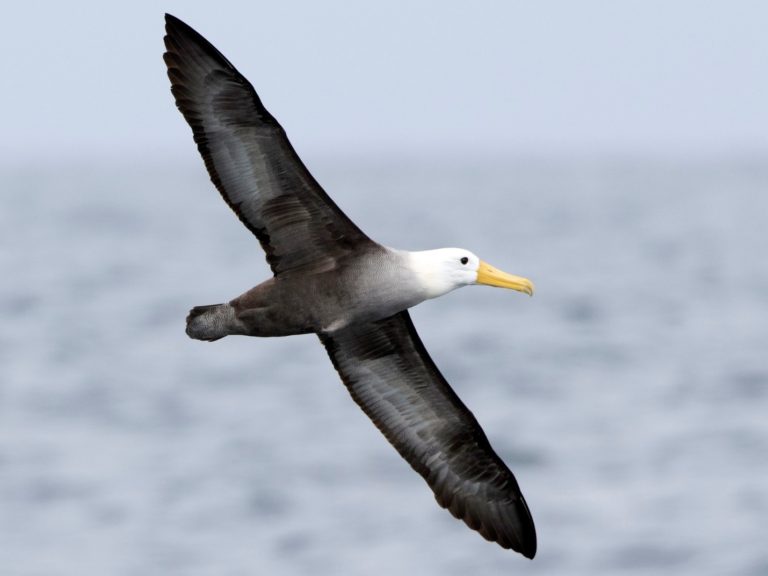
Waved Albatross. (Offshore from Isla San Lorenzo, Lima, Peru; July 12, 2017.) © Brian Sullivan
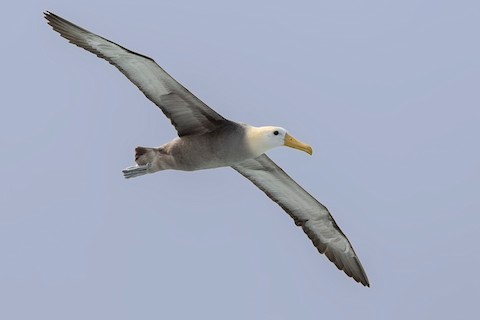
Waved Albatross. (Punta Suarez, Isla Española, Galápagos, Ecuador; July 25, 2019.) © Bradley Hacker

Waved Albatross with wings raised, showing the fine vermiculated pattern on its underparts—the “waved” pattern for which it is named. (Punta Suarez, Isla Española, Galápagos, Ecuador; December 24, 2008.) © Phil Green
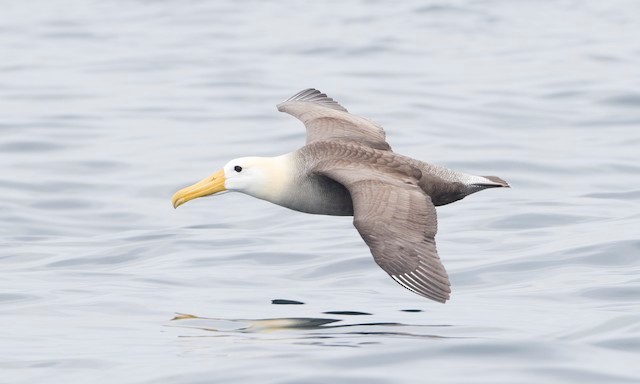
Waved Albatross. (Offshore from Isla San Lorenzo, Lima, Peru; July 12, 2017.) © Brian Sullivan

Waved Albatross. (Offshore from Puerto de Lomas, Arequipa, Peru; July 2, 2021.) © Peter Kaestner

Waved Albatross. (Punta Suarez, Isla Española, Galápagos, Ecuador; July 25, 2019.) © Bradley Hacker

Waved Albatross, pair in courtship display. (Isla Española, Galápagos, Ecuador; November 2018.) © Joshua D. Vandermeulen
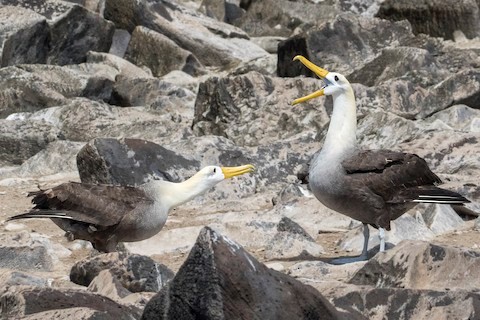
Waved Albatross, pair in courtship display. (Punta Suarez, Isla Española, Galápagos, Ecuador; July 25, 2019.) © Bradley Hacker
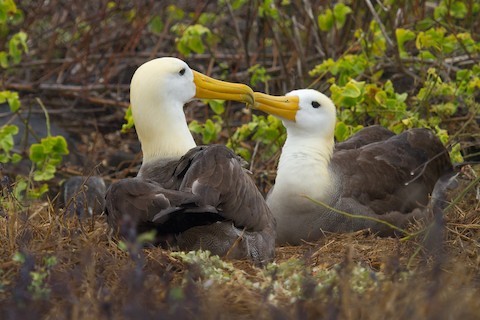
Waved Albatross, pair at nest. (Punta Suarez, Isla Española, Galápagos, Ecuador; July 30, 2018.) © David Marques

Waved Albatross. (Isla Española, Galápagos, Ecuador; July 2018.) © William Hull
References
BirdLife International. 2018. Phoebastria irrorata. The IUCN Red List of Threatened Species 2018: e.T22698320A132641638. https://dx.doi.org/10.2305/IUCN.UK.2018-2.RLTS.T22698320A132641638.en. (Accessed November 29, 2021.)
eBird. 2021. eBird: An online database of bird distribution and abundance. Cornell Lab of Ornithology, Ithaca, N.Y. http://www.ebird.org. (Accessed November 29, 2021.)
Harrison, P. 1983. Seabirds: An Identification Guide. Houghton Mifflin, Boston.
Howell, S.N.G. 2012. Petrels, Albatrosses & Storm-Petrels of North America. Princeton University Press.
Howell, S.N.G., and K. Zufelt. 2019. Oceanic Birds of the World. Princeton University Press.
Martínez Piña, D.E., and G.E. González Cifuentes. 2021. Field Guide to the Birds of Chile. Princeton University Press.
McMullan, M., and T. Donegan. 2014, Field Guide to the Birds of Colombia (Second Edition). Fundación Proaves de Colombia, Bogotá.
Onley, D., and P. Scofield. 2007. Albatrosses, Petrels & Shearwaters of the World. Princeton University Press.
Ridgely, R.S., and P.J. Greenfield. 2001. The Birds of Ecuador, Volume II: Field Guide. Cornell University Press.
Ridgely, R.S., and J.A. Gwynne. 1989. A Guide to the Birds of Panama (Second Edition). Princeton University Press.
Schulenberg, T.S., D.F. Stotz, D.F. Lane, J.P. O’Neill, and T.A. Parker. 2007. Birds of Peru. Princeton University Press.
Xeno-Canto. 2021. Waved Albatross – Phoebastria irrorata. https://www.xeno-canto.org/species/Phoebastria-irrorata. (Accessed November 29, 2021.)

